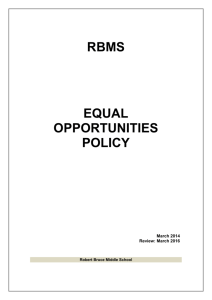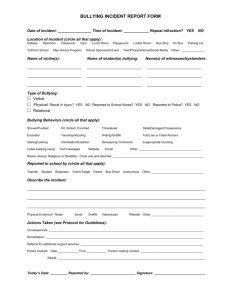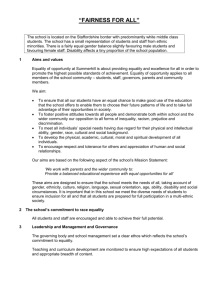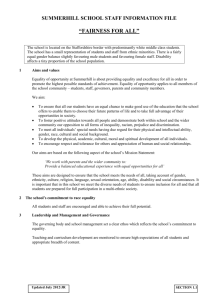anti-bullying & dealing with prejudice related incidents policy
advertisement
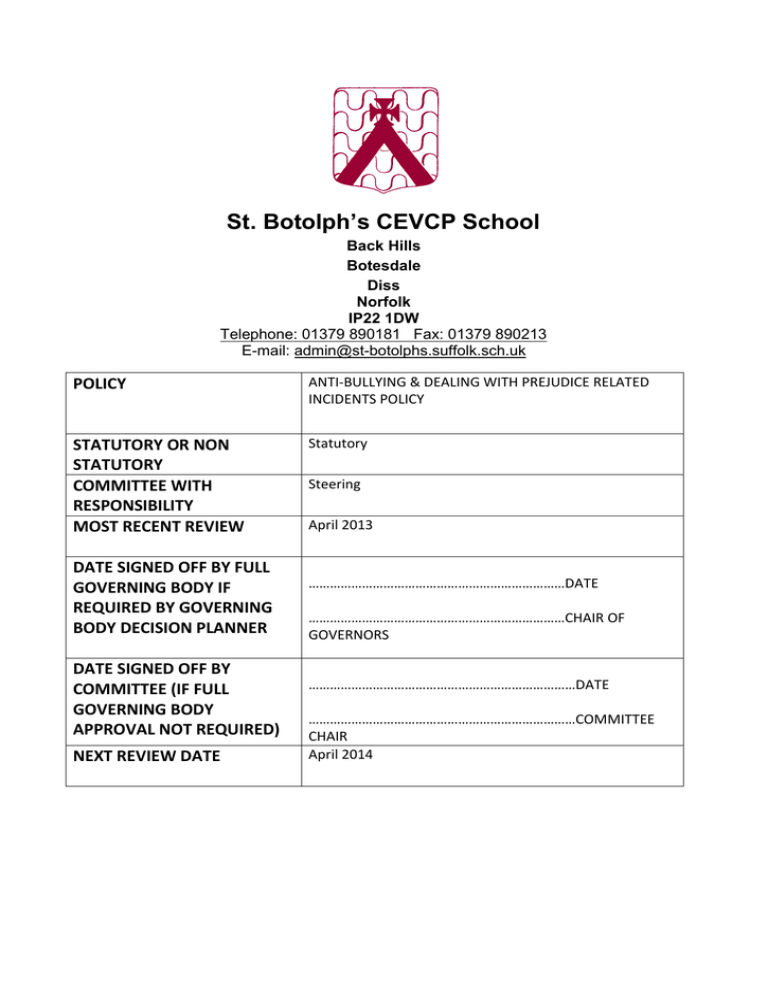
St. Botolph’s CEVCP School Back Hills Botesdale Diss Norfolk IP22 1DW Telephone: 01379 890181 Fax: 01379 890213 E-mail: admin@st-botolphs.suffolk.sch.uk POLICY ANTI-BULLYING & DEALING WITH PREJUDICE RELATED INCIDENTS POLICY STATUTORY OR NON STATUTORY COMMITTEE WITH RESPONSIBILITY MOST RECENT REVIEW Statutory DATE SIGNED OFF BY FULL GOVERNING BODY IF REQUIRED BY GOVERNING BODY DECISION PLANNER DATE SIGNED OFF BY COMMITTEE (IF FULL GOVERNING BODY APPROVAL NOT REQUIRED) NEXT REVIEW DATE Steering April 2013 ………………………………………………………………DATE ………………………………………………………………CHAIR OF GOVERNORS …………………………………………………………………DATE …………………………………………………………………COMMITTEE CHAIR April 2014 ANTI-BULLYING & DEALING WITH PREJUDICE RELATED INCIDENTS POLICY This policy was updated to incorporate the Local Authority Advice and Guidance on Dealing with Prejudice Related Incidents in Schools. This policy incorporates the Dealing with Racist Incidents in Schools Advice and Guidance. Parents are referred to the advice contained at Appendix 3 in this policy. Page 2 of 21 Aims of the Policy The aims of this policy are: To work towards ensuring an environment where all children feel safe, happy and secure in school. To ensure that all pupils, staff, parents and governors have an understanding of what bullying and prejudice mean and their impact on the victim’s emotional wellbeing. To ensure that all pupils, staff and parents have guidance and strategies to deal with and resolve bullying and prejudice related incidents when they occur. To eliminate racism and sexism in our school. To encourage children to behave in a responsible manner toward each other, taking responsibility for their own behaviour in accordance with our behaviour policy. To ensure that the curriculum teaches why bullying/prejudice is unacceptable and how it can be dealt with. To ensure that the school’s safeguarding procedures are considered and/or implemented if appropriate. Underlying Principles Each bullying and prejudice related incident holds unique and distinctive features, which need to be considered; schools’ responses should be informed by the principles below. These principles need to be adopted if schools are to challenge and counter prejudice related incidents and ensure the wellbeing and achievement of all children and young people within the school community in line with Every Child Matters. All pupils are entitled to an education, which respects and values their identity, individuality and background and is free from prejudice, harassment and adverse discrimination. Prejudice related bullying could prevent children from learning and be a significant barrier to their achievement. Prejudice related bullying impacts on a child’s social and emotional wellbeing. Strategies for dealing with discrimination need to be linked to the schools behaviour policy. All staff, children, parents, carers and governors should be aware of the school’s policy and procedures for dealing with prejudice related incidents. All allegations of prejudice related bullying should be taken seriously and investigated thoroughly. Schools should keep parents, carers and children informed during an investigation and advise them of any action that is taken. This should be discussed sensitively with the child or young person beforehand. Schools and the Local Authority will be open and honest in their dealings with pupils, parents, carers and members of local communities about prejudice related incidents and will value their help and support in tackling these issues. Page 3 of 21 Definition of Bullying We consider that bullying is repeated, deliberate behaviour that makes another person feel threatened, distressed, hurt or upset. Occasionally the distress caused may not be consciously intended by the perpetrator, this will depend upon the perpetrator’s age and ability to understand the consequences of their behaviour. Definition of Prejudice Related Incidents A racist incident is any incident which is perceived to be racist by the victim or any other person. A disability related incident is any incident which is perceived to be so by the victim or any other person. A homophobic related incident is any incident which is perceived to be homophobic by the victim or any other person. Furthermore, the victim does not have to be lesbian, gay or bisexual to experience homophobic bullying, but may be targeted because they are perceived to be gay, or because a member of their family is gay, for example. Forms of Bullying and Prejudice Related Incidents Verbal (Name-Calling, Taunting, Mocking) This covers name-calling, insults, threats and prejudice related ‘jokes'; and incitement of others to behave in a prejudiced way. It also includes ridicule of a person's appearance, speech/accent, background, religion, culture; the regular use, consciously or unconsciously of offensive and discriminatory language. An example of this would be the ‘casual’ use of homophobic language such as the use of “gay” to mean “stupid”. Staff will challenge all such derogatory language. Written This includes offensive writing, drawings, emails and text messages as well as items posted on the web, including social networking sites. Graffiti This includes offensive writing and drawings in public places and anywhere in the school such as walls, desks, and toilets. Physical This includes a range of violent actions involving hitting, kicking, and the use of weapons, pushing, shoving or tripping someone. Intimidation/coercion This includes making fun of children and adults, offensive gestures, mimicry, intimidating body language and obstruction, for example when entering a school classroom or within the school environment, as well as making someone do or say something against their will. Extortion Extortion specifically relates to forcing someone to give up something they own, or have in their custody, such as money, personal possessions or school property. Page 4 of 21 Personal possessions taken or damaged This includes deliberately damaging or breaking a person's property, spoiling or destroying a piece of work, hiding a pupil's bag, pens, shoes and other personal property or the school’s property that is in the possession of or being used by the victim. Isolation, being ignored or left out This includes a refusal to sit next to or work with another child, for example, in working groups, lunchtime queues, and playground activities. Spreading rumours The spreading of rumours and/or malicious gossip, particularly with the intention of causing hurt those named in the rumours. Cyber (Email, Internet, text) Cyberbullying is the use of Information Communications Technology (ICT), particularly mobile phones and the internet, deliberately to upset someone else. As such, technology is often the vehicle for the bullying, and therefore spreading rumours, for example, may be done via the internet, and would therefore be both ‘Spreading rumours’ and ‘Cyber.’ Please refer to the school’s E-Safety policy for further detail/guidance on the use of the internet. Other prejudice related incidents This includes the wearing of specific badges, T-shirts carrying slogans or bringing discriminatory literature into school; attempting to recruit others to organisations and groups that promote any form of prejudice. Normal Peer Conflict or Bullying? The harm caused by bullying/prejudice should not be underestimated. It can cause considerable stress to children, to the extent that it affects their health and development. Normal Peer Conflict or Bullying? Normal Peer Conflict Equal power or friends. Happens occasionally. Accidental or not pre-meditated harm. Not seeking power or attention. Generally not trying to get something. Remorse – will take responsibility. Bullying Imbalance of power – not friends. Repeated unwelcome actions. Deliberate harm or the threat of physical or emotional harm. Seeking power, control of material things. May attempt to get material things or power. No remorse – may blame the victim. Action we can take to prevent bullying/prejudice related incidents It is important that we create an atmosphere in school where victims of bullying/prejudice feel able to tell an adult what is happening; put their side of the argument; and know that they will be listened to and heeded. Also children accused of bullying/prejudice behaviour should feel able to tell their side of the story and be listened to. Page 5 of 21 How this can be achieved: Raise the awareness of what bullying and prejudice are through direct teaching – PSHE (personal, social and health education), SEAL (Social and emotional aspects of learning) and incidental discussions, including assemblies. All members of the school community creating a caring, calm, ordered and friendly atmosphere in school. Parents are informed of incidents of bullying/prejudice by the child’s class teacher and offered advice on how to support their child, be they victim or perpetrator. Children feel valued, by means of teaching through the curriculum and displays; recognition of achievement; rewards and celebrating varied heritages. Ensure that consistent behaviour management and high quality activities are available at playtimes and lunchtimes. All members of the school community follow policy and are consistent when handling incidents. The promotion of anti-bullying/prejudice campaigns, eg Anti-Bullying Week. Canvass pupils’ views on the extent and nature of bullying. Ensure that where appropriate, safeguarding is considered. Ensure that the school’s Behaviour Policy is implemented where appropriate. Signs and Symptoms of Bullying A child may indicate by signs or behaviour that he or she is being bullied. Adults should be aware of these possible signs and that they should investigate if a child: refuses to go outside at break times or refuses to stay at school for school dinners requests to change classes or school behaves immaturely, i.e. the child reverts to a previous behaviour such as thumbsucking becomes withdrawn, clingy, moody, uncooperative or non-communicative finds it difficult to concentrate or school performance deteriorates is frightened of walking to or from school begs to be driven to school changes their usual routine – time leaving or route taken to/from school is unwilling to go to school (school phobic) begins truanting becomes withdrawn, anxious or lacking in confidence starts stammering attempts or threatens suicide or runs away self-harms (eg scratches themselves) cries themselves to sleep at night or has nightmares feels ill in the morning begins to do poorly in school work comes home with clothes torn or books damaged has possessions “go missing" asks for money or starts stealing money (to pay bully) has dinner or other monies continually "lost" has unexplained cuts or bruises comes home starving (money / lunch has been stolen) becomes aggressive, disruptive or unreasonable is bullying other children or siblings stops eating is frightened to say what's wrong is afraid to use the internet or mobile phone Page 6 of 21 is nervous or jumpy when a text/MSN message or email is received gives improbable excuses for any of the above. These signs and behaviours could indicate other problems but bullying should be considered a possibility and should be investigated. Responding to Bullying or Prejudice Related Incidents All bullying and prejudiced behaviour should be treated as a serious matter. It is crucially important that the member of staff who first encounters the incident shows firm disapproval and takes positive action to deal with the situation. A failure to respond could be seen as condoning prejudiced behaviour and could discourage pupils and parents / carers from reporting incidents and sharing their concerns with staff. Prompt, appropriate and consistent responses from all members of staff can encourage pupils who might otherwise suffer in silence to report incidents and share their concerns and worries. In dealing with the perpetrators of prejudice related bullying or other discriminatory incidents, it is important that it is the behaviour that is disapproved of and not the pupils themselves. Effective action could include: drawing the perpetrator to one side and explaining clearly and calmly why the behaviour was wrong and hurtful or offensive; seeking an assurance that the pupil understands why the behaviour was wrong and that it will not be repeated; correcting any misinformation that was used as part of the prejudice related behaviour; where an assurance is forthcoming, asking the pupil to apologise for his or her action, where possible mediate between the children or young people; investigating the background or particular circumstances which led up to the incident – witnesses should be sought to verify the account; referring the matter, where appropriate, to a senior member of staff for disciplinary action; arranging a meeting or informing the parents / carers in order to make it clear to them that such behaviour is unacceptable and that further disciplinary action will be taken if there is any repetition (if such behaviour appears to be condoned or encouraged by the parents, staff should refer the parents to the headteacher) ; in appropriate cases, considering the use of positive strategies other than sanctions and punishment that might help and encourage the pupil to overcome his or her prejudices and to desist from engaging in similar behaviour in the future; checking the recording and reporting data to see if the pupil has been involved in any earlier incidents. If this is the case, a senior member of staff should meet with the parents / carers of the perpetrator. The meeting should enlist the support of Page 7 of 21 these parents and carers to stop such behaviour and to stress that a similar incident in the future could have serious consequences for the child. In some cases, this could lead to a fixed-term or permanent exclusion and possible action by the police if the aggrieved victim took action against the perpetrator. Safe to Learn: Homophobic Bullying, contains detailed, step-by-step approaches for dealing with homophobic incidents, including scripted responses for how to support a pupil who has been the victim of homophobic bullying as well as ideas for how to address homophobic bullying at Key Stage 1, 2, 3, 4 and 16+. Consideration and implementation of “consequences” under the school’s Behaviour Policy. Consideration of whether any safeguarding issues have arisen and possible implementation of the school’s Safeguarding Policy. Recording and Reporting Procedures Members of school staff may not be sure when they should record an incident as prejudice-related following remarks made by children related to ethnicity, culture, religion, disability or homophobia. The following questions may be helpful to assist this decision. If the answer to any of the following 3 questions is ‘Yes’ then the incident should be recorded: 1. was anyone offended/hurt/upset by the remark? 2. would a representative of the community concerned have been offended? (If in doubt record) 3. was the way the remark was formulated or delivered derogatory, mocking or negative about the group or individual or character concerned? (if in doubt record) Every incident that is perceived to be based on prejudice should be reported and recorded, however minor it may appear at the time. All bullying or prejudice related incidents (except racist) must be recorded on the appropriate School Bullying Report Form (See Appendix 1). Racist related incidents must be recorded on the Racist Incident Report Form (See Appendix 2). The above forms will be issued to staff and should be kept in class behaviour folders. Extra copies of the forms can be obtained from the Headteacher or Deputy Head. Completed forms must be passed on to the Headteacher. All completed forms will be kept in a secure file called the School’s Anti-Bullying/Prejudice Log. The Headteacher will be responsible for overseeing the reporting procedure and monitoring the incidence of prejudice related incidents on a regular basis. Page 8 of 21 The information provided by these records will be reported annually to governors by the Headteacher and provide data for the annual statistical return to the Local Authority. It is a legal requirement for racist incidents to be reported and it is recommended as best practice for disablist and homophobic incidents also to be reported to the Local Authority. The completion of School Bullying Report Forms and Racist Incident Report Forms will be undertaken by teachers and teaching assistants. Other members of staff should report incidents to the class teacher or a member of senior staff for action to be taken. Following up an incident It is often helpful, once the immediate situation has been dealt with, for staff to reflect on the incident, to consider what further action may be necessary in respect of the perpetrator and victim and to see if there are any lessons to be learned from the experience. Effective action could include: Considering the actions of the perpetrator to see if there were any underlying causes which may have prompted this behaviour; Checking data records to see if the pupil has been involved in any previous incidents. If this is the case, a senior member of staff should meet with the parents of the perpetrator, seek their support in stopping such behaviour and make them aware that a similar incident in the future could have serious consequences for their child; Monitoring the perpetrator's future behaviour; Considering which other members of staff need to be informed, for example, the Headteacher, Key Stage co-ordinator, head of year or class teacher; Checking to see if there are any times in the school day, or any places in the school, where pupils feel particularly vulnerable. If so, try to find ways of overcoming this. For example, if incidents have occurred in the playground, check that staff are on the alert for such behaviour at lunch and break times; Considering if it would be beneficial to discuss the issues further in a school assembly or class discussion. This requires careful judgement. It may expose the victim in an embarrassing and uncomfortable way and could be treated inappropriately by other pupils. On the other hand, it may be an opportunity to develop positive attitudes towards diversity. This will help pupils to understand the damaging effects of prejudice and the determination of the school to combat this. Asking all members of staff to keep a protective eye on a known victim(s) of prejudice and taking positive steps over time to build up their trust and to encourage them to report any further incidents; Making sure all members of staff are alert for other pupils who may be suffering in silence; Page 9 of 21 Asking all members of staff to keep a watchful eye on known perpetrators to prevent further prejudiced incidents. Consequences & Support Consequences for the inappropriate actions of the perpetrator are important but may not prevent further incidents of bullying. It is, therefore, essential that the perpetrator is helped to understand the impact of their actions; the reasons for their actions and then given strategies and support to prevent recurrence. This may require long-term in-school support and the involvement of external agencies. Consequences may include: detentions (at break time and/or lunch time), isolation and/or exclusion. Support for the victim may include: 1:1 time with an adult to help build self-esteem; peer support; a “trusted” adult at lunchtime who is fully aware of the issues and can offer protection; regular home-school contact between parents and teachers; “open-door” policy for parents with class teacher and senior leaders; access to nurture group facilities. Support for the perpetrator may include: 1:1 time with an adult to help build self-esteem and social skills; social skills group work, peer support; a “trusted” adult at lunchtime who is fully aware of the issues and is able to rapidly intervene in any incident; regular homeschool contact between parents and teachers; “open-door” policy for parents with class teacher and senior leaders; access to nurture facilities; pastoral support programme if a risk of permanent exclusion. Page 10 of 21 Dealing with a Bullying or Prejudice Related Incident A Step-by-Step Checklist Incident If you witness the incident: intervene immediately to protect the victim express disapproval to the perpetrator and prevent further escalation - Intervene reinforce school rules on prejudice related incidents - If you receive a report of the incident: - to gather evidence, carry out an investigation - identify and interview any witnesses Support and reassure the victim Record details on School Bullying Report Form (SBRF) or Racist incident form. Inform the parents / carers of both victim and perpetrator at or by the end of the school day. Check past records to see if the perpetrator or victim has been involved in any previous incidents Consider and implement as appropriate any procedure under Safeguarding and Behaviour Policies. Consider and implement any immediate or longer-term follow-up action arising from the incident Consider and address any general lessons for existing school policy and practice to be addressed through the School Development Plan Page 11 of 21 Appendix 1 Page 12 of 21 SCHOOL BULLYING REPORT FORM 1. School/Establishment St Botolph’s CEVCP School 2. Date and time incident reported 3. Person who reported incident Victim Other (please specify) 4. Type of incident (please tick) Extortion Personal possessions taken/damaged Isolation/Being Ignored or Left Out Written Physical Spreading Rumours Verbal (Name-Calling, Taunting, Mocking) Intimidation/coercion Cyber (Email, Internet, Text) Graffiti Other (please specify) If you feel the incident was motivated by any of the following please tick Appearance Racism/Ethnic Origin * Disability/SEN Sexual Orientation Gender/Sexism Transgender Faith, Religion or Belief Home Circumstances including Looked After Child (LAC/CiC) * Reminder: These incidents should be recorded separately. Details of Young People involved Names 1 2 3 4 5 6 *Role: V Victim Year Group P Perpetrator(s) Gender A Associate 5. Have parents/carers of victim been informed? Have parents/carers of perpetrators been informed? Repeat victim? Yes Ethnic Origin Code (refer to school census data) No Page 13 of 21 Role* B Bystander Yes No Yes No 6. Brief summary of incident (including location) 7. Perpetrator known to victim (by sight or name) Yes No Known details: Repeat perpetrator? Yes No 8. Summary of Agreed Action (including future preventative work) Record completed by Date Signature of Designated Member of Staff Page 14 of 21 Appendix 2 Page 15 of 21 SCHOOL RACIST INCIDENT REPORT FORM A racist incident is any incident which is perceived to be racist by the victim or any other person 1. School/Establishment 2. Person who reported incident Victim Other (please specify) 3. Date and time incident reported 4. Who identified the incident as Racist? Victim Other (please specify) 5. Victim Details First name Family name First language/dialect Year group Male Female Have parents of victim been informed? Repeat victim? Yes Yes No [If this is a repeat victim please refer to section 5 of LEA guidance] No 6. Ethnicity of Victim A White British Irish Traveller of Irish Heritage Gypsy/Roma Any other white background, please write in B Mixed White & Black Caribbean White & Black African White & Asian Any other mixed background, please write in C Asian or Asian British Indian Pakistani Bangladeshi Any other Asian background, please write in D Black or Black British Caribbean African Any other black background, please write in E Chinese or other ethnic group Chinese Any other, please write in In addition: Tick if the victim was an Asylum Seeker or Refugee Page 16 of 21 7. Type of incident Verbal abuse Written abuse Racist graffiti Physical assault Intimidation Damage Ostracism Other (please specify) 8. Details of incident (including date, time and place) 9. Perpetrator Details First name Family name First language/dialect Year group Male Female Have parents of perpetrator been informed? Yes No 10. Ethnicity of Perpetrator [use categories in Section 6] 11. Perpetrator known to victim (by sight or name) Yes No Repeat perpetrator? guidance] Yes Known details: [If this is a repeat perpetrator please refer to section 4 of LEA No 12. Summary of Agreed Action Record completed by Date Signature of Designated Member of SMT Page 17 of 21 Appendix 3 Page 18 of 21 DON’T SUFFER IN SILENCE Advice for parents and families on how to support their children and the school in combating Bullying and Prejudice Every school is likely to have some problem with bullying at one time or another. Your child’s school has an anti-bullying policy and uses it to reduce and prevent bullying. Bullying is repeated, deliberate behaviour that makes another person feel threatened, distressed, hurt or upset. Occasionally the distress caused may not be consciously intended by the perpetrator, this will depend upon the perpetrator’s age and ability to understand the consequences of their behaviour. It is not acceptable in school (or in UK law) for any person to show prejudice through racist, homophobic or disablist behaviour. Any incident that is perceived to be racist, homophobic or disablist, by the victim or any other person, will be investigated and recorded by the school. The perpetrator and victim of such prejudice behaviour will be treated in accordance to the school’s policy. Bullying and Prejudice Related Behaviour can take a variety of forms and may include: Verbal (Name-Calling, Taunting, Mocking) This covers name-calling, insults, threats and prejudice related ‘jokes'; and incitement of others to behave in a prejudiced way. It also includes ridicule of a person's appearance, speech/accent, background, religion, culture; the regular use, consciously or unconsciously of offensive and discriminatory language. An example of this would be the ‘casual’ use of homophobic language such as the use of gay to mean stupid. Staff will challenge all such derogatory language and expect the same challenge from parents at home. Written This includes offensive writing, drawings, emails and text messages as well as items posted on the web, including social networking sites. Graffiti This includes offensive writing and drawings in public places and anywhere in the school such as walls, desks, and toilets. Physical This includes a range of violent actions involving hitting, kicking, and the use of weapons, pushing, shoving or tripping someone. Intimidation/coercion This includes making fun of children and adults, offensive gestures, mimicry, intimidating body language and obstruction, for example when entering a school classroom or within the school environment, as well as making someone do or say something against their will. Page 19 of 21 Extortion Extortion specifically relates to forcing someone to give up something they own, or have in their custody, such as money, personal possessions or school property. Personal possessions taken or damaged This includes deliberately damaging or breaking a person's property, spoiling or destroying a piece of work, hiding a pupil's bag, pens, shoes and other personal property or the school’s property that is in the possession of or being used by the victim. Isolation, being ignored or left out This includes a refusal to sit next to or work with another child, for example, in working groups, lunchtime queues, and playground activities. Spreading rumours The spreading of rumours and/or malicious gossip, particularly with the intention of causing hurt those named in the rumours. Cyber (Email, Internet, text) Cyberbullying is the use of Information Communications Technology (ICT), particularly mobile phones and the internet, to deliberately upset someone else. As such, technology is often the vehicle for the bullying, and therefore spreading rumours, for example, may be done via the internet, and would therefore be both ‘Spreading rumours’ and ‘Cyber.’ Other prejudice related incidents This includes the wearing of specific badges, T-shirts carrying slogans or bringing discriminatory literature into school; attempting to recruit others to organisations and groups that promote any form of prejudice. Parent and families have an important part to play in helping schools deal with bullying and prejudice related behaviour. Discourage your child from using bullying/prejudice behaviour at home or elsewhere. Show your child how to resolve difficult situations without using violence or aggression. Signs and Symptoms of Bullying: A child may indicate by signs or behaviour that he or she is being bullied. Adults should be aware of these possible signs and that they should investigate if a child: refuses to go outside at break times or refuses to stay at school for school dinners requests to change classes or school behaves immaturely, i.e. the child reverts to a previous behaviour such as thumbsucking becomes withdrawn, clingy, moody, uncooperative or non-communicative finds it difficult to concentrate or school performance deteriorates is frightened of walking to or from school begs to be driven to school changes their usual routine – time leaving or route taken to/from school is unwilling to go to school (school phobic) begins truanting Page 20 of 21 becomes withdrawn, anxious or lacking in confidence starts stammering attempts or threatens suicide or runs away self-harms (eg scratches themselves) cries themselves to sleep at night or has nightmares feels ill in the morning begins to do poorly in school work comes home with clothes torn or books damaged has possessions “go missing" asks for money or starts stealing money (to pay bully) has dinner or other monies continually "lost" has unexplained cuts or bruises comes home starving (money / lunch has been stolen) becomes aggressive, disruptive or unreasonable is bullying other children or siblings stops eating is frightened to say what's wrong is afraid to use the internet or mobile phone is nervous or jumpy when a text/MSN message or email is received gives improbable excuses for any of the above. These signs and behaviours could indicate other problems but bullying should be considered a possibility and should be investigated. If your child has been bullied: Talk to your child calmly about it. Make a note of what your child says – particularly who was involved; how often the incidents have happened; where they happed and what exactly happened. Reassure your child that telling you about the bullying was the right thing to do. Explain that any further incidents should be reported to a teacher immediately. Explain the problems that your child is experiencing to their class teacher. Keep in touch with the school until the problem has been resolved. Talk with teachers about bullying: Try to stay calm – bear in mind that the teacher may have no idea that your child is being bullied or may have heard conflicting accounts. Be as specific as possible about what your child says has happened – give dates, places and the names of other people involved. Make a note of what action the school intends to take. Ask if there is anything that you can do to help your child at school. Remember that the school has to help both victims and bullies. Stay in touch with the school – let them know if things improve as well as if the problems continue. Further help and advice for parents can be obtained from: Kidscape Parents’ Anti-Bullying Line 08451 205 204 Page 21 of 21 www.kidscape.org.uk


